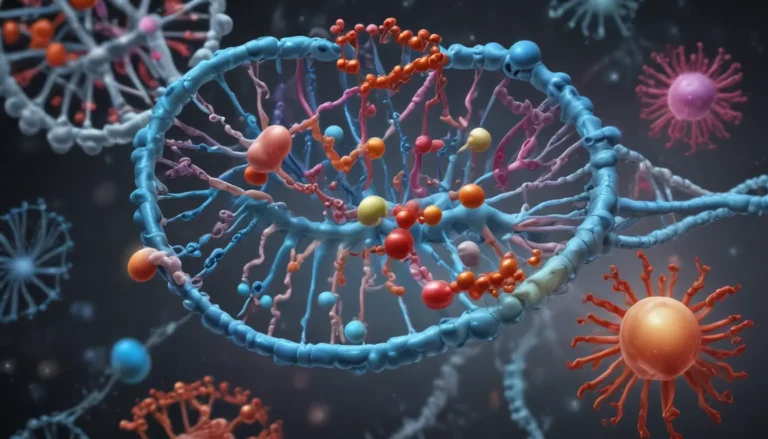A Note About Images: The images used in our articles are for illustration purposes only and may not exactly match the content. They are meant to engage readers, but the text should be relied upon for accurate information.
Welcome to the fascinating realm of the somatosensory system, a remarkable network that allows us to sense touch, pain, temperature, and proprioception. From the moment we enter the world, this intricate system guides our interactions and perceptions, enriching our experiences in ways we might not even realize.
Exploring the Marvels of the Somatosensory System
Let’s delve into the wonders of the somatosensory system and uncover 20 unbelievable facts that will deepen your appreciation for this vital sensory system. Each fact sheds light on the complexity and ingenuity of this incredible system, inviting you to marvel at its capabilities.
The Vital Role of the Somatosensory System
The somatosensory system is essential for our survival and well-being, allowing us to perceive touch, pressure, temperature, and pain. Without this system, we would struggle to navigate our surroundings and protect ourselves from potential harm.
The Diversity of Sensory Receptors
Within the somatosensory system, a variety of sensory receptors work together to process different sensations. Mechanoreceptors detect touch and pressure, thermoreceptors sense temperature, and nociceptors respond to pain, collectively contributing to our sensory experiences.
The Skin’s Sensory Abilities
Our skin is a fascinating organ with the remarkable ability to detect various sensations, including light touch, pressure, vibration, and even tickling. Its sensitivity allows us to interact with the world in unique ways, shaping our experiences and perceptions.
Sensory Richness in Our Hands
The hands, with their dense concentration of nerve endings, are exceptionally sensitive to touch. The intricate network of sensory nerves in our fingertips enhances our tactile perception, making these body parts highly responsive to our environment.
The Brain’s Processing Power
Sensory information gathered by the somatosensory system is transmitted to the brain for interpretation. This sophisticated process enables us to make sense of the sensations we experience, forming the foundation of our sensory perception.
From Sensation to Movement
In addition to processing sensory information, the somatosensory system plays a crucial role in motor control. By providing feedback to the brain, it enables precise movements and coordination, enhancing our physical abilities.
Shaping Our Perception of the Physical World
Through receptors in our fingertips and palms, the somatosensory system allows us to discern the shape, texture, and size of objects we touch. This tactile information enriches our perception of the physical world, guiding our interactions with our environment.
Specialized Receptors for Pain
Nociceptors, specialized pain receptors scattered throughout the body, play a vital role in alerting us to potential tissue damage or injury. These receptors transmit signals to the brain, signaling the presence of pain and the need for attention.
Distinguishing Different Types of Pain
Not all pain is the same, and the somatosensory system excels at distinguishing between various types of pain, such as sharp, dull, burning, or throbbing. Each type of pain carries unique sensory information, informing our responses to different stimuli.
The Intriguing Phenomenon of Phantom Pain
Individuals who have lost a limb may still experience sensations, including pain, in the missing limb. This phenomenon, known as phantom pain, highlights the continued activity of the somatosensory system, even in the absence of physical structures.
Influences on Sensory Sensitivity
Factors like temperature, hormone levels, and medical conditions can affect the sensitivity of the somatosensory system. For instance, colder temperatures can heighten our tactile perception, making us more responsive to touch stimuli.
Enhancing Balance and Spatial Awareness
Together with the vestibular system, the somatosensory system contributes to our sense of balance and spatial orientation. By providing feedback about our body’s position and movement, it helps us maintain stability and coordination.
The Role of Proprioception
Proprioception, the ability to perceive the position and movement of our body parts without visual feedback, relies on the somatosensory system. This crucial function enables us to navigate our environment with precision and awareness.
Adaptation and Habituation
The somatosensory system exhibits sensory adaptation, a process where continuous stimuli lead to decreased sensitivity over time. This phenomenon explains why we may stop feeling the weight of a watch or tightness of clothing after prolonged exposure.
The Center of Sensory Processing
Located in the parietal lobe of the brain, the somatosensory cortex is responsible for processing and interpreting sensory information from the somatosensory system. This cortical region plays a key role in our perception of touch and proprioception.
A Universal System Among Animals
The somatosensory system is not exclusive to humans but is present in many other animals, allowing them to perceive touch, pain, and other sensations. From primates to cats and dogs, various species rely on this system for sensory experiences.
Emotions and Sensory Processing
The somatosensory system’s connections with the limbic system, responsible for regulating emotions, highlight the profound link between sensory processing and emotional responses. Touch and physical sensations can evoke powerful emotional reactions, reflecting the deep integration of our sensory experiences with our emotional well-being.
Early Development and Lifelong Adaptation
The development of the somatosensory system begins even before birth, with specialized neurons and receptors gradually forming as the nervous system evolves. Throughout life, this system continues to adapt and change in response to experiences, training, injuries, and other influences, showcasing the remarkable plasticity of the human brain.
Unveiling the Marvels of Biology
The somatosensory system’s intricacies and capabilities are a testament to the wonders of human biology. From perceiving the world around us to guiding our movements and providing vital feedback, this system showcases the extraordinary complexity of our sensory experiences. By unraveling its secrets, we gain a deeper appreciation for the remarkable mechanisms that enable us to navigate our environment and interact with the world.
Unlocking the Mysteries of the Somatosensory System
In conclusion, the somatosensory system stands as a testament to the incredible capabilities of the human body. Its role in perceiving touch, pressure, temperature, pain, and proprioception is essential for our interactions with the world. By delving into the intricacies of this system, we gain a newfound respect for the complexities that shape our sensory experiences and enhance our understanding of the world around us.
FAQs: Exploring the Somatosensory System
- What is the primary function of the somatosensory system?
-
The somatosensory system is responsible for interpreting touch, pressure, temperature, pain, and proprioception, guiding our sensory experiences.
-
How does the somatosensory system work?
-
Through specialized receptors in the skin, nerve transmission, and brain processing, the somatosensory system interprets sensory information and enables us to perceive and respond to stimuli.
-
What is proprioception, and why is it important?
-
Proprioception refers to sensing the position and movements of body parts without visual cues. It plays a vital role in spatial orientation, coordination, and motor control.
-
How is the somatosensory system studied and understood?
-
Scientists utilize various techniques, such as neuroimaging, electrophysiology, and behavioral experiments, to investigate the functioning of the somatosensory system and its interactions with the brain.
-
Can injuries or diseases affect the somatosensory system?
- Yes, injuries or diseases can disrupt the somatosensory system, leading to sensory deficits or conditions like neuropathy, phantom limb pain, or sensory processing disorders.
Embark on a journey of discovery and wonder as you explore the intricate world of the somatosensory system. From the delicate receptors in our skin to the processing centers in our brain, each component of this system contributes to our sensory experiences, enriching our understanding of ourselves and the world we inhabit. Join us in celebrating the marvels of biology and the remarkable abilities that enable us to perceive, interpret, and interact with our environment.






